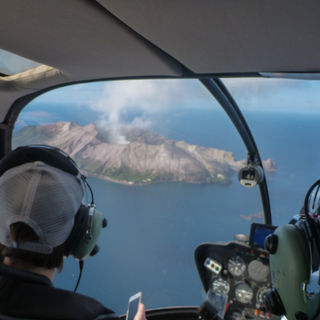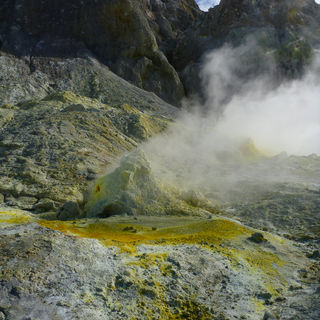WILD WHAKAARI
INSIDE A DEADLY ACTIVE VOLCANO
The trip described here took place before the disastrous events of 2019 which forever changed the lives of 25 travellers and tragically took the lives of 22 others.
I’m incredibly fortunate that my time on White Island ended positively. I can only imagine the terror endured by those who were taken by the power of Whakaari that day.
Te Puke is located in the western Bay of Plenty. Apparently, it’s the kiwi capital of New Zealand. Now, I know what you’re thinking. The elusive, iconic, nocturnal national bird that is endangered and almost impossible to see. If you’re going to spot one anywhere, surely the kiwi capital is the place to do it.
Well, not quite.
Te Puke is the kiwi fruit capital of New Zealand. Sorry to disappoint.
Rumour has it there’s even a kiwi fruit theme park. To hammer home the point, we’re greeted by a giant kiwi fruit statue as we roll into town in the Mazda Bongo camper van that my friends have been living out of for the past year.
I’m here in New Zealand for about three weeks as I travel with them around the North Island.
Said friends, Alice and Meg, have mentioned that we’ll be staying the next couple of nights with a mate of theirs - some guy they’d met whilst volunteering on a tall ship that sailed to Fiji. Of course they did.
That mate’s name is Graeme, and he’s kindly offered to let us crash in his sleepout, located alongside his family home, nestled beautifully within their kiwi orchard.
As we pull into the driveway, we are greeted by Graeme, a tall, broad man leaning heavily into a pair of crutches, and his wife Karen - a smiling, friendly face with curly blonde hair.
Alongside them, their gorgeous sulphur-crested cockatoo dances along its perch. I struggle to catch its name above the greeting squawks, which accompany the raising and lowering of bright yellow feathers on its head crest.

That evening is spent getting to know Karen and Graeme over a much-appreciated hot meal. I’m struck by the warmth of the family and feel an immediate sense of familiarity and comfort in their presence. Graeme speaks passionately about their kiwi orchard and mentions that, alongside it, they also run a helicopter company. “Perhaps you can take a trip out tomorrow”, he says as we clear the table and prepare to turn in for the night.
“A trip?” I think to myself. “Over the kiwi orchards perhaps?” Sounds like fun.
The next morning, I wake, well-rested from a night in the sleepout, to another cracking day in New Zealand. The sun's out, the birds are singing, I'm living the dream. I find Graeme at the house. He’s just as merry and sociable this morning as he was last night - cheerily chattering as he swings on his crutches to manoeuvre through the kitchen with apparent ease. He’s already on with the first important task of the day - coffee.
Now, anyone who knows me knows I’m a serious tea-drinker. Even for a Brit, I drink significantly more than average. But Graeme’s coffee is incredible. I sip slowly, savouring every inch as we chat and oil our morning brains into a higher gear. He mentions that our ‘trip’ will be later that day, and that we’ll be going to White Island. “Sweet”, I silently think, without giving much more time to what that actually means. With a name like White Island, I’m imagining pale sandy beaches, maybe a few palm trees, something along those lines.
In the meantime, Karen will take us hiking up the nearby Papamoa Hills. Just a short drive later, we begin our ascent of the green trails, where we each take turns eagerly quizzing Karen about the extraordinary life she shares with Graeme in this beautiful part of the world. As we climb higher, the landscape is revealed, with fields and patchwork orchards as far as the eye can see. Karen starts to talk about Graeme and goes on to describe what caused his reliance on crutches. He’d been involved in an accident as he piloted one of his helicopters. The aircraft came down and Graeme was half paralysed as a result. Karen speaks with emotion as she relives the day it all happened, from receiving the phone call to believing she’d lost Graeme forever.
Thankfully, that didn’t happen and, against the odds, Graeme still flies to this day.

We follow Karen from the house and down to the helicopter hangar, where we’re introduced to our pilot, Dave. Graeme's there too, and he runs us through the safety briefing. It goes something like, you know, don’t put your arms near the spinning things, stay buckled in at all times and oh, when you land inside the volcano…”
Wait. When we do what inside the where?!
Of course, what I hadn’t realised is that White Island is New Zealand’s most active volcano. Situated about 30 miles from the east coast in the Bay of Plenty, the island covers an area of approximately 800 acres, which is just the peak of a much larger submarine volcano.
And so here we are, now strapped into a tiny red helicopter, about to fly directly into its crater.

As the propellers whirl above us, we’re lifted into the air and rise in an arc around the orchards. Not before long, the landscape switches from green to blue and there’s nothing but deep inky ocean below us. Continuing out in pursuit of the horizon, I look down at the glimmering waves below. As if from nowhere, the blue ripples are interrupted by flashes of white, appearing then disappearing in their hundreds. The unmistakable dance of dolphins. This is the biggest pod I’ve ever seen and there's far too many to count. My heart swells as they race us below, like marine gazelles leaping across the ocean savanna.
And then, I see it. One of the most awesome and surreal images that will forever live in my mind’s eye.
White Island, Whakaari.

Like a mound of grey clay thrown onto the pottery wheel of blue waves, White Island grows in size as we fly closer and closer. As a cone volcano, it almost has the signature look that you’d expect - being roughly circular in shape and wider at the bottom than the top. The crater spills out of one side, as the wall of the cone cascades into the ocean. Inside, a bubbling and steaming green lake awaits. We approach through the entrance of the fallen side and land within the crater. We are completely alone in this place.
I step down from the helicopter and onto another planet. My eyes busily ingest all that I’m seeing as my mind tries to process the scenes, desperately grasping at any frame of reference to process what I’m looking at. But I have nothing. I’ve never seen anything like this before.


It’s like we’re in an enormous cathedral on Mars, only this Mars isn’t red. It’s more like a fluorescent yellow and green, as though the rock faces have been painted with glow-in-the-dark paint. I think about the dancing crest of Graeme’s cockatoo, which isn’t far off the same colour.
This trippy colouration is caused by gases, which billow from chimneys and bubble from pools of thick grey liquid all around us. These gases are rich in hydrogen sulphide. When the hot gas comes into contact with the atmosphere, it cools, oxidises and forms yellow crystals of pure sulphur around the fumarole vents and on the rocks.
As you can imagine, with this much sulphur, the smell is quite overpowering. We wear gas masks to protect ourselves from the toxic fumes, as well as hard hats in case rocks are ejected into the air.

We’re instructed to follow Dave’s footsteps carefully and not to stray from his path, for the ground might look firm, but in many areas the crust is very thin. Below the thin surface lies liquid magma, hot enough to instantly strip the flesh from your foot should you step through the top layer and into the liquid beneath.

Cautiously, we make our way towards the frothing celadon lake, where jets of pale gas roar from the crater walls all around us. I’m not thinking about much, there’s not much to think when you’re faced with a place so volatile and so alien. I stood for a while, eyes like saucers, mouth dropped open, just staring at the immensity of this place.


There are no real signs of life here. Nothing runs, grows or flies. But that's not to say it doesn't feel alive. There is movement, there's noise and there's an abundance of power and energy. No living beings, perhaps - but this small crater on the surface of the Earth offers a glimpse into the body of the beast and the lifeblood that flows within our planet.
Back towards the shore, we find the heavily rusted remains of mining equipment and the ghostly outlines of small buildings. On 10th September 1914, disaster struck a group of 10 miners working to extract sulphur on White Island. The crater wall collapsed and the miners were engulfed by the resulting lahar (mudflow). The only survivor was Peter the Great, a camp cat, who was found hungry but uninjured three weeks later. This equipment, now frozen in place, offers a stark reminder of the dangers that come with a place this wild.
Heading back towards our little red ‘copter, I try to take in as much as I can. There’ll never be enough time, though, to truly absorb these surroundings. As the chopper lifts away, the three of us, Alice, Meg and I, sit dazed and amazed. Barely speaking. Stunned.
I’m trying my best to re-regulate my nervous system and stop every cell in my body from vibrating when squeals of joy rattle through the speakers in my headset. The cause of such excitement - a huge whale right below us. Its dark silhouette glides just below the surface as we all struggle to contain what little remaining cool we might have. Then, as if something from a documentary, the whale breaks through the surface of the ocean - revealing its enormous back and dorsal fin before diving into the depths and out of sight.
From where we were (both physically and psychologically at this point) it’s hard to identify the species. However, it’s known that humpback and blue whales, which can grow to lengths of 16 and 25 metres respectively, pass through these shores as they migrate north to warmer waters around this time. Dave explains that he’s only ever seen three whales whilst flying this coast, making our sighting of this one surfacing even more special.
For some time afterwards, I felt completely overwhelmed by what had happened that day. Without a doubt, these incredible experiences still stand out as some of the most impactful of my life to date. This unbelievable gift from an amazingly kind and generous family helped to further ignite my passion for wildlife and travel. Whilst not every travel day or wildlife encounter is as dramatic as these, my trip to White Island helped me realise the true power of experiences with nature - from the very big to the very small.
This adventure is one of the reasons I am committed to sharing ethical experiences with wild animals in their natural habitats. However, what White Island gave to me is nothing compared to what it later took from explorers just like me. Mother Nature is truly unpredictable and her power can never be underestimated.
Thank you, eternally, Graeme and Karen. The two days I spent with you will be impossible to forget.
Whakaari/White Island is considered ancestral land belonging to the Ngāti Awa iwi. Ngāti Awa holds a deep spiritual connection to the island, viewing it as a living ancestor and a sacred place.









